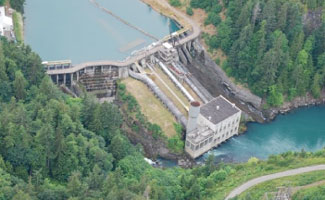Feds give salmon more water
by Joel Preston Smith
This article was originally published in June 2012

The federal government recently acknowledged that salmon have a hard time swimming through concrete walls. It’s too late for the native sockeye salmon population on the Elwah River — they’re extinct — but the dozers are rolling, and the two tombs that for the past 99 years have buried 70 miles of wild river are finally coming down.
On March 16, workers removed a final barrier around the Elwha Dam, allowing the river to flow in its native channel for the first time since 1912, when developers in northwest Washington decided the state needed voltage more than it needed salmon, wild rivers, or Lower Elwha Klallam Indians, the latter of whom depended on seasonal returns of salmon for more than just “power,” or “energy,” or even just “food.”
Aerial photos of the revived Elwha show, for the first time in living memory, a river that looks like … a river. Not a domesticated, demure slough, but a vibrant, unpredictable watercourse — braided, weaving sinuously, unfettered, free.
Mostly free. When the Glines Canyon Dam — eight miles upstream from the Elwha Dam — removal is completed sometime around summer of next year, all of the Elwha will let down her hair. For the Lower Elwha Klallam (and for others), this means a river that once again welcomes salmon into its furthest reaches. The U.S. National Park Service estimates that before construction on the dams began in 1910, as many as 400,000 salmon spawned in the 70 miles of main stem and tributaries.
That number now stands at about 3,000 migrants — all trapped at the 108-foot Elwha Dam, five miles inland from the Elwha’s mouth in the Salish Sea. Only about 100 to 200 winter steelhead were able to outmigrate to the Strait of Juan de Fuca as far back as 2008, according to a technical memorandum by the National Oceanic and Atmospheric Administration.
The demolitions mean hope, of course, and renewal. The Elwha constitutes the largest watershed (270 square miles) in Olympic National Park, and the return of major salmon runs would return marine-derived nutrients to the watershed, restoring a vital food source for the range of life that inhabits it.
For consumers, the teardowns mean more good, and possibly more goods — if the Elwha’s salmon recover. But stacking more fish on a plate is not the best reason to bulldoze this or any dam. It was that same “utilitarian” viewpoint that led developers to favor jobs and profits over salmon and Indians.
Valuing the “corporate” bottom line led entrepreneurs to erect the dam on gravel, not bedrock, which would have increased the dam’s cost. Favoring a flow of money (over a steady stream of water) led to the dam being designed without fish ladders — a blueprint for the salmon’s destruction.
When the dam burst (it later was reconstructed) on Oct. 30, 1912 during heavy rains, the Olympic-Leader later reported that the resulting 18-foot “tidal wave” left “great numbers of salmon and trout strewn over the fields and through the woods, and everyone going down that way got all the fish they could carry home.” What we now would call a tragedy was then a windfall.
The National Park Service seems exceptionally proud of the teardown. The agency posted a video covering the troubled history of the Elwha’s dams, and in it, you can hear counter-currents of antiquated pragmatism versus a more modern existential view of why salmon must live and dams must go (view video »).
A series of narrators explains, “The cost of keeping the dams has cast a shadow over their benefits … We were going to have to spend an enormous amount of money to allow fish passage, which is tremendously expensive … The machinery was going to have to be replaced …”
If the narrative stopped there, viewers might be left with the impression that someone’s back pocket had made the decision to kill the Elwha and Glines Canyon dams. Congress authorized their removal in 1992, then failed — until recently — to appropriate enough funds to demolish them. But then there’s Robert Elofson, restoration director for the Lower Elwha Klallam Tribe, who reminds us of a higher form of accounting — why dams must go, and fish must come.
“We want our dammed salmon back … Our hopes are that our grandkids can see the same Elwha River our grandparents saw.”
Joel Preston Smith is a writer and photographer living in Portland.
